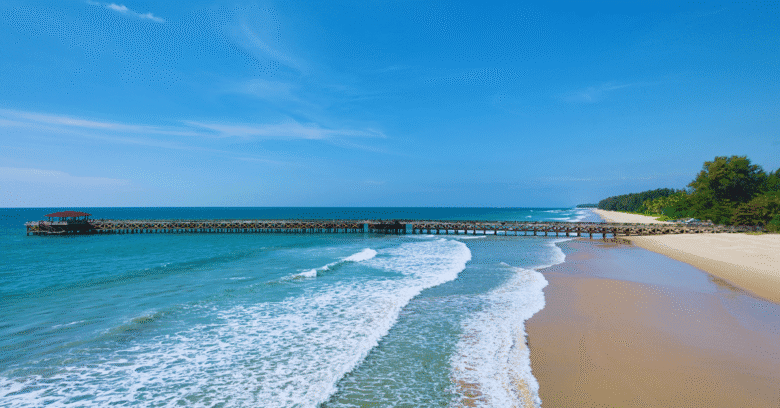Natai Beach, located in Phang Nga Province, is one of the most pristine and tranquil beaches in southern Thailand. Just 25 kilometers from Phuket town, it feels like an entirely different world. Beyond its stunning blue waters and fine white sand during the day, Natai Beach is also an exceptional destination for seaside stargazing at night.Stargazing at Natai Beach isn’t just an ordinary evening activity—it’s an experience that connects you with the magnificence of the universe, accompanied by the gentle sound of waves, pure sea air, and peaceful surroundings.
Why Natai Beach is Perfect for Stargazing
- Low light pollution – Dark skies, clear stars
- Long beach – Not crowded with people
- Cool sea breeze – Comfortable for extended viewing
- Sunset viewing before stargazing begins
- Many resorts reduce outdoor lighting at night
Quick Tips
- Choose nights during the waning moon phase
- Avoid full moon nights
Prominent Stars, Constellations, and Planets
- Milky Way – Most visible from March to October, after midnight
- Orion – Prominent from December to February; M42 nebula easily visible
- Meteor showers – Eta Aquarids in May, Delta Aquarids in July
- Beehive Cluster (M44) – Appears as a fuzzy patch; beautiful through binoculars
- Planets – Venus, Mars, Jupiter, Saturn visible to the naked eye
Best Times and Seasons to Visit
Ideal Season
- November to April – Clear skies, minimal rain
Nighttime Schedule
- 1-2 hours after sunset – Stars begin appearing
- Prime stargazing window – 2-3 hours after midnight
Moon Phase
- Best during new moon or thin crescent phases
Preparation, Equipment, and Safety
Helpful Equipment
- Mat or reclining chair
- Red flashlight
- Binoculars (7×50 or 10×50)
- Star map app on mobile device
- Camera with tripod for astrophotography
- Power bank
Personal Items
- Light jacket
- Mosquito repellent
- Drinking water and snacks
Safety Precautions
- Go in groups
- Inform your accommodation before heading out
- Avoid waterline in darkness
- Remember the route back
Daytime Activities
- Swimming – Clear, inviting water
- Stand-up paddleboarding (SUP) – Relatively calm waters
- Kayaking – Explore the coastline
- Snorkeling – Nearby spots
- Horseback riding along the beach – Morning or evening
- Spa and Thai massage – Relax before your stargazing night
- Beach yoga – Early morning sessions
- Day trips to Phang Nga Bay and waterfalls in Phang Nga
Simple Astrophotography Techniques
- Manual mode (M) – Wide aperture, f/2.8 if available
- ISO 1600-6400 depending on sky conditions
- Shutter speed 15-25 seconds
- Tripod is essential
- Use 2-second timer to reduce shake
- Take multiple shots and try stacking later
Benefits for Mind and Body
- Reduces stress through connection with nature
- Develops meditation skills and patience
- Sparks scientific curiosity and learning
- Strengthens family and couple bonds
- Creates lasting memories
Protecting the Night Sky
- Use lighting only when necessary
- Use warm or red-colored lights
- Turn off unnecessary outdoor lights
- Always take trash back with you
- Support local shops and communities
Quick Science Facts Worth Knowing
- Stars are other suns located far away
- The Milky Way is our galaxy
- Shooting stars are space dust burning up in the atmosphere
- Star colors indicate temperature and age
Star Legends to Share by the Beach
- Orion – The legendary hunter
- Taurus and Perseus – From Greek mythology
- Dao Thai (Plough) or Dao Jorakae (Crocodile) – Thai wisdom used to indicate seasons
Frequently Asked Questions
How do I get to Natai Beach?
- From Phuket Airport, drive north approximately 30-40 minutes to reach the beach
When is the Milky Way easiest to see?
- March to October, most prominent after midnight
What equipment should I prepare?
- Mat, chair, red flashlight, mosquito repellent, drinking water, star map app
- Binoculars enhance the experience










